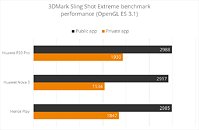- Joined
- Oct 9, 2007
- Messages
- 47,421 (7.51/day)
- Location
- Hyderabad, India
| System Name | RBMK-1000 |
|---|---|
| Processor | AMD Ryzen 7 5700G |
| Motherboard | ASUS ROG Strix B450-E Gaming |
| Cooling | DeepCool Gammax L240 V2 |
| Memory | 2x 8GB G.Skill Sniper X |
| Video Card(s) | Palit GeForce RTX 2080 SUPER GameRock |
| Storage | Western Digital Black NVMe 512GB |
| Display(s) | BenQ 1440p 60 Hz 27-inch |
| Case | Corsair Carbide 100R |
| Audio Device(s) | ASUS SupremeFX S1220A |
| Power Supply | Cooler Master MWE Gold 650W |
| Mouse | ASUS ROG Strix Impact |
| Keyboard | Gamdias Hermes E2 |
| Software | Windows 11 Pro |
UL Benchmarks de-listed several popular Huawei devices from its database over proof of cheating in its benchmarks. Over the month, it was found that several of Huawei's devices, such as P20 Pro, Nova 3, and Play; overclocked their SoCs while ignoring all power and thermal limits, to achieve high benchmark scores, when it detected that a popular benchmark such as 3DMark, was being run. To bust this, UL Benchmarks tested the three devices with "cloaked" benchmarks, or "private benchmarks" as they call it. These apps are identical in almost every way to 3DMark, but lack the identification or branding that lets Huawei devices know when to overclock themselves to cheat the test.
The results were startling. When the devices have no clue that a popular benchmark is being run (or if has no way of telling that 3DMark is being run), it chugs along at its "normal" speed, which is 35% to 36% lower. The rules that bind device manufacturers from advertising UL's 3DMark scores explicitly state that the device must not detect the app and optimize its hardware on the fly to ace the test. Huawei responded to UL by stating that it will unlock a new "performance mode" to users that lets them elevate their SoCs to the same high clocks for any application.

View at TechPowerUp Main Site
The results were startling. When the devices have no clue that a popular benchmark is being run (or if has no way of telling that 3DMark is being run), it chugs along at its "normal" speed, which is 35% to 36% lower. The rules that bind device manufacturers from advertising UL's 3DMark scores explicitly state that the device must not detect the app and optimize its hardware on the fly to ace the test. Huawei responded to UL by stating that it will unlock a new "performance mode" to users that lets them elevate their SoCs to the same high clocks for any application.

View at TechPowerUp Main Site







 .
.